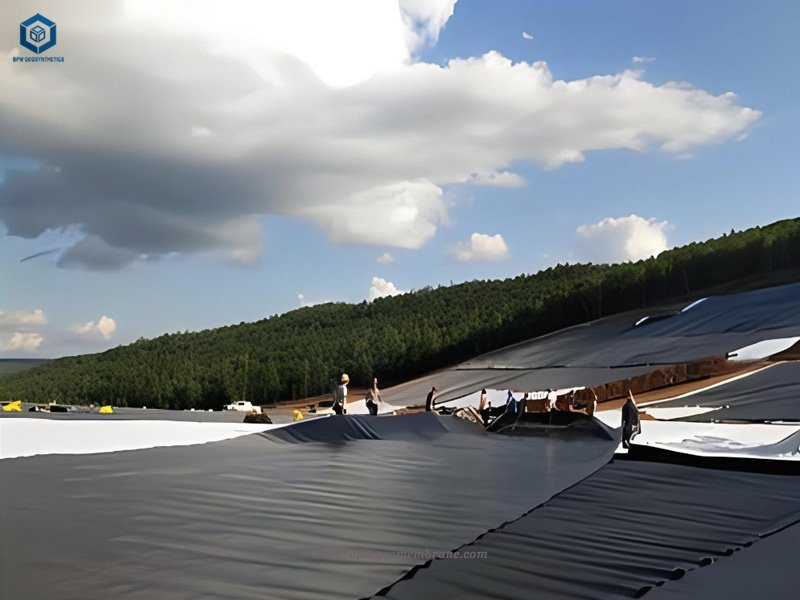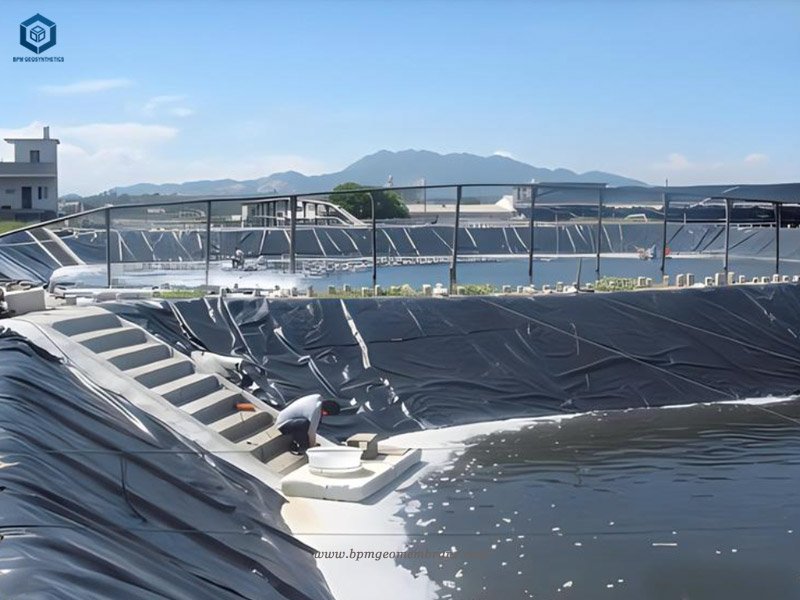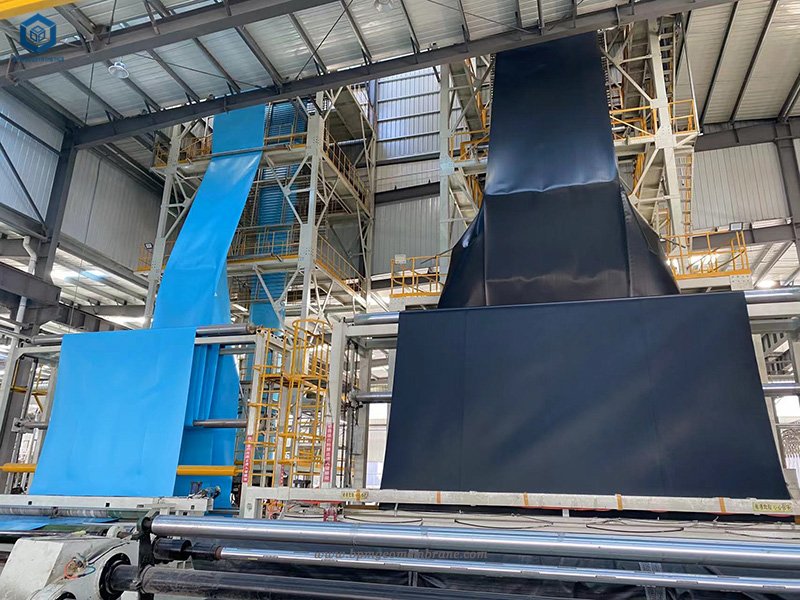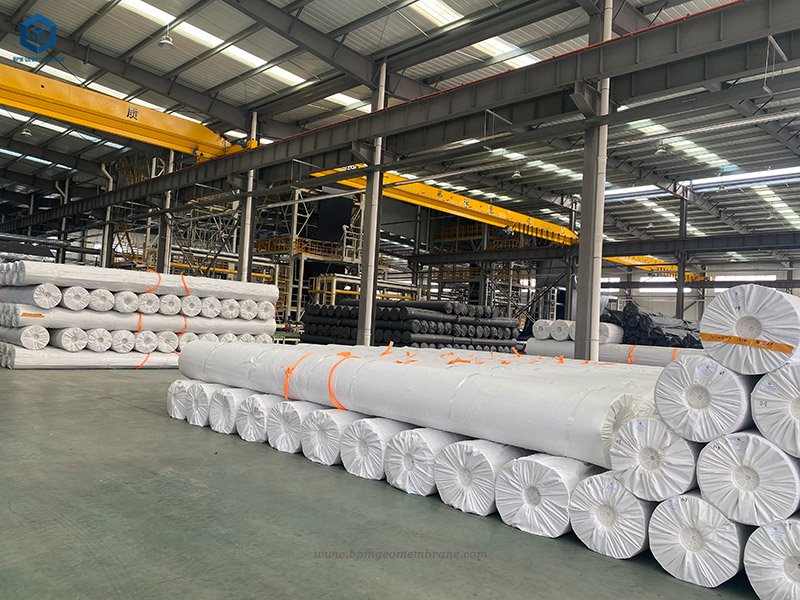A HDPE liner or high density polyethylene liner is a type of geomembrane liner used in various applications to provide containment, protection, and barrier properties. It is made from a high-density polyethylene resin, a strong and durable thermoplastic material.
HDPE liners are commonly used in environmental and civil engineering projects, such as landfills, mining operations, wastewater treatment facilities, agricultural ponds, and industrial containment systems. They serve as a barrier to prevent the seepage of liquids, gases, and contaminants into the surrounding soil or groundwater.
HDPE geomembrane liners have their excellent chemical resistance, high tensile strength, puncture resistance, and flexibility. They can be fabricated into large panels or custom-sized sheets to fit the specific requirements of a project. HDPE liners are typically installed by overlapping and heat-welding the seams to create a seamless and watertight barrier.
HDPE liners are UV-stabilized to withstand prolonged exposure to sunlight without degradation. This feature ensures their long-term performance in outdoor applications.
HDPE liners are widely used due to their cost-effectiveness, durability, and versatility in providing environmental protection and containment solutions.
BPM Geomembrane is the leading HDPE liner manufacturer and supplier, we wholesale a wide range of HDPE geomemrbane liner with custom size and thickness at best factory price.
1. What Is HDPE Liner Used For?
In addition to the environmental and civil engineering applications mentioned earlier, HDPE liners are commonly used in various other industries and settings. Here are some additional applications where HDPE liners are frequently utilized:
Pond and Reservoir Liners: HDPE liners are widely used to line ponds, reservoirs, and water storage facilities to prevent seepage and maintain water quality. They help in water conservation, irrigation, aquaculture, and recreational purposes.
Tank Liners: HDPE liners are employed as tank liners in industrial settings to provide chemical resistance and prevent leakage or contamination. They are used in storage tanks for chemicals, acids, petroleum products, and other hazardous materials.
Secondary Containment: HDPE liners are used in secondary containment systems to prevent leaks or spills from storage tanks, pipelines, or industrial equipment. They act as a secondary barrier to protect the environment and prevent the spread of pollutants.
Landfill Liners and Covers: HDPE liners are extensively used in landfill construction to create a barrier between the waste and the surrounding soil or groundwater. They prevent the migration of leachate (liquid waste) and gas emissions, contributing to environmental protection.
Mining Applications: HDPE liners are utilized in mining operations for tailings ponds, heap leach pads, and containment systems. They help in containing and managing mining by-products and preventing the release of potentially harmful substances into the environment.
Geotechnical Engineering: HDPE liners are employed in geotechnical engineering projects such as retaining walls, soil barriers, and erosion control systems. They provide stability, prevent erosion, and offer moisture barriers in various construction applications.
Floating Covers: HDPE liners can be used as floating covers on reservoirs, lagoons, and wastewater treatment ponds. These covers help reduce evaporation, control odors, and minimize the growth of algae or other unwanted organisms.
Agriculture and Aquaculture: HDPE liners are used in agriculture for irrigation canals, water storage ponds, and lining agricultural pits. They also find application in aquaculture for fish ponds, hatcheries, and shrimp farming.


2. How Thick Is HDPE Liner?
HDPE liner is known for their thickness, ranging from 20 mils up to 120 mils (0.5–3 mm). The choice of thickness directly impacts the liner’s permeability, strength, weight, roll length, flexibility, and cost. Thicker liners tend to have lower permeability, meaning they are less prone to allow liquids or gases to pass through. This allows for customization based on project requirements.
Common thickness options for HDPE liners include 0.5mm, 1mm, 1.5mm, 2mm, and 3mm. Among these, the most widely used thicknesses are 40 mil (1 mm) and 60 mil (1.5 mm), striking a balance between strength, permeability, and cost. HDPE liners with these thicknesses find applications in various fields, including potable and reserve water storage, containment systems, agricultural ponds, and dairy ponds.
The appropriate thickness can ensure that the HDPE liner meets their specific needs, providing the desired level of protection, durability, and cost-effectiveness.
3. How Are HDPE liners Installed in Pond And Reservoir Applications?
HDPE liners are installed in pond and reservoir applications using a specific installation process to ensure proper placement and secure containment. Here is a general overview of the installation steps:
Site Preparation: The area where the pond or reservoir will be constructed is cleared, ensuring the surface is smooth, free from rocks, debris, and sharp objects that could potentially damage the liner.
Subgrade Preparation: The subgrade, which is the soil or compacted fill material beneath the liner, is prepared to provide a stable base. It may involve compacting the soil, removing any organic materials, and achieving the desired slope or grade.
Anchor Trenches: Anchor trenches are excavated around the perimeter of the pond or reservoir area. These trenches will be used to secure and anchor the liner in place.
Liner Placement: The HDPE liner is rolled out over the prepared subgrade, starting from one end and gradually unrolling it across the entire surface area. Care is taken to minimize wrinkles and folds in the liner.
Seaming: HDPE liners are typically supplied in large panels, so multiple panels may be required to cover the entire area. The panels are overlapped, and the seams are heat-welded together using specialized equipment. The heat welding process melts the HDPE material, creating a strong and watertight bond.
Anchor Trench Backfill: Once the liner is in place, the anchor trenches are backfilled with soil or other suitable materials. This helps secure the liner and prevents it from shifting or moving.
Edge Termination: The liner edges are secured and terminated using various methods depending on the design and requirements of the project. Common edge termination techniques include burying the liner edge, using anchor trenches, or installing concrete or geotextile blocks.
Testing and Inspection: After installation, the liner system is inspected for any defects or damage. Leak testing may be performed to ensure the integrity of the liner and its ability to contain water or other fluids.
4. Are There Any specific Guidelines or Regulations for HDPE Liner Installation in Pond and Reservoir Applications?
There are specific guidelines and regulations that govern the installation of HDPE liners in pond and reservoir applications. These guidelines aim to ensure proper installation, safety, and environmental protection. While specific regulations may vary depending on the region and the intended use of the pond or reservoir, here are some general considerations:
Regulatory Compliance: It is essential to comply with local, state, and federal regulations governing the construction and operation of ponds and reservoirs. These regulations may include permits, environmental impact assessments, and compliance with water quality standards.
Design and Engineering: The design of the pond or reservoir, including liner specifications, slope requirements, and capacity calculations, should be performed by qualified engineers or professionals experienced in geomembrane applications. The design should consider factors such as anticipated loads, hydrostatic pressures, and site-specific conditions.
Material Selection: Select HDPE liner materials that meet the required specifications, including thickness, density, and chemical resistance. Ensure that the liners comply with relevant industry standards, such as ASTM (American Society for Testing and Materials) or GRI (Geosynthetic Institute) guidelines.
Installation Quality Assurance: Proper installation techniques and quality assurance measures should be followed to ensure the integrity of the liner system. This may include visual inspections, seam testing, and documentation of installation procedures.
Welding Procedures: The welding of HDPE liner seams should be performed by trained and certified technicians following specific welding procedures recommended by the liner manufacturer. Welding equipment should be properly maintained and calibrated.
Leak Testing: Conduct leak testing after installation to verify the integrity of the liner system. Common methods include vacuum testing, hydrostatic testing, or electrical leak location surveys. The testing protocol should be in accordance with industry standards and project requirements.
Monitoring and Maintenance: Establish a monitoring and maintenance plan to regularly inspect the liner system for any signs of damage, degradation, or potential issues. This may involve periodic inspections, water level monitoring, and addressing any necessary repairs promptly.


5. What Are Some Common Requirements for Liner Thickness and Leak Detection in Pond and Reservoir Applications?
The specific requirements for liner thickness and leak detection in pond and reservoir applications can vary depending on factors such as the intended use of the facility, local regulations, and engineering considerations. However, here are some common requirements and recommendations:
Liner Thickness: The liner thickness for pond and reservoir applications is typically determined based on factors such as the anticipated loads, water height, and the desired level of containment. Thicker liners are generally used for applications with higher water pressures or for increased durability. Typical HDPE liner thicknesses for pond and reservoir applications can range from 0.5 mm (20 mil) to 2.0 mm (80 mil) or more.
Leak Detection: Leak detection systems are an important component of pond and reservoir applications to identify potential leaks or breaches in the liner system. Common leak detection methods include:
5.1 Visual Inspections
Regular visual inspections of the liner surface, particularly in areas where leaks are more likely to occur, such as seams, penetrations, and transitions.
5.2 Electrical Leak Location Survey (ELL)
This method involves passing a low-voltage electrical current through the liner system and monitoring for any voltage differences that indicate the presence of leaks or breaches.
5.3 Hydrostatic Testing
This method involves filling the pond or reservoir with water and monitoring the water level for any significant drop, which could indicate a leak.
5.4 Geophysical Surveys
Geophysical techniques, such as ground-penetrating radar (GPR) or seismic methods, can be used to detect and locate leaks or voids beneath the liner.
The selection of leak detection methods should consider factors such as the size of the facility, the importance of leak detection, and regulatory requirements.





